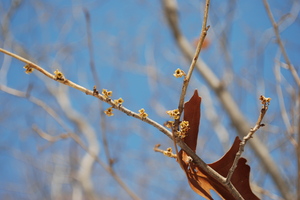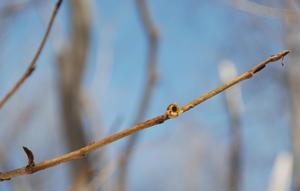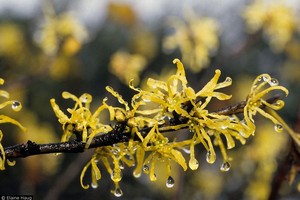A minor native plant mystery: Shrub turns out to be witch hazel

Mystery shrub I found on a nature walk two weeks ago.
Rick Meader|Contributor
Last week, we talked about skunk cabbage, a native plant whose name doesn’t do it justice (but it is descriptive). This week, let’s talk about a shrub I came upon a few weeks ago on a nature walk. I was looking for something, anything, that was blooming. The skunk cabbage wasn’t out where I was, but I did find little yellow flowers on a multi-stemmed shrub that reached about 10 feet tall.
The shrub’s naked bud (no bud scales) made me think it could be witch-hazel (Hamamelis virginiana), and the little brown things near the flower also looked witch-hazely, but the flowers didn’t. Also, witch-hazel blooms in October and November (which makes it a very nice shrub to have in your yard - it stretches out the blooming season until the snow flies), not February. Also, witch-hazel’s flowers have four strappy yellow petals whereas this shrub’s flowers didn’t have any such petals, but it sure looked like it was blooming.

Rick Meader|Contributor

Witch-hazel (Hamamelis virginiana) in bloom
Photo by Elaine Haug. Provided by Smithsonian Institution, Department of Systematic Biology-Botany
I was mystified. The mystery was solved by David Michener and Bob Grese of the Matthaei Botanical Gardens and Nichols Arboretum. This was, in fact, a witch-hazel. The flowers were left over from last fall and had lost their petals over the winter, but the flower base had remained. You learn something new every day!
Let’s learn a bit more about witch-hazel, which is one of my favorite native understory tree/shrubs, mostly because of its late-blooming flowers, but also because of its growth habit. First, witch-hazel is not the same as Hazelnut (Corylus americana), which is also a shrub, but which is more often found in open site conditions (and is otherwise quite different), whereas witch-hazel is most commonly found in open forests, such as oak-hickory forests, and doesn’t generally like wet conditions. Witch-hazel can grow in a multi-stemmed shrub form, as the one I found did, or in a small tree form. Its tree form is roughly rounded, with an open form. Its leaves are crenate, or sort of scallop-shaped with rounded teeth, and are about 3-5 inches in diameter, and turn yellow in the fall. The shrub form usually gets around 10-15 feet tall; the tree form can reach up to 30 feet tall, but it is a pretty slow grower.
There is a species of witch-hazel that blooms in the spring (Hamamelis vernalis), but it is not native to Michigan. It is commonly known as Ozark Witch-hazel and is native to Arkansas, Missouri, Oklahoma and Texas.
Witch-hazel was used by Native Americans for such diverse uses as colds, pain relief, hunger stimulation and skin troubles, among many others. Even today, we use it as an astringent, and to aid with sore muscles. In the category of “neat things about this plant”, the seed pods are pretty cool. When they’re fully ripe, the pods “explode” and fire their seeds out, helping to increase their distribution. The “post explosion” remnants of the pod are the brown things in the first photo. This “behavior” helps the plant increase its distribution area but makes collecting the seeds a bit tricky, as you have to time it just right. So, if you’re walking near a witch-hazel in late fall, beware of plant gunfire, even if it’s not hunting season.
Enjoy nature everyone!
Rick is a local landscape architect with a special interest in all things natural, including native plants and the critters that eat them. You can contact him at yourland1824@gmail.com.


Comments
dufus
Sat, Mar 27, 2010 : 2:27 p.m.
Hi, Rick. I blogged about witch hazel recently here. The bush I saw on campus is a different variety than yours I guess. If the bush you saw is accessible to the public would you tell us where? thx, Jerry
Rick Meader
Wed, Mar 10, 2010 : 2:28 p.m.
Thanks, Rork. I think that's a very interesting site, too. It's always interesting to see how Native Americans used certain plants. I hope people are smart enough not to try it themselves, though. We have no idea what they might have mixed the stuff with, how it was prepared, or if it was even very effective. Rick Rick
Rork Kuick
Tue, Mar 9, 2010 : 12:50 p.m.
I want to plug http://herb.umd.umich.edu/, it is a nice site for American ethnobotany. It lists things native people used the plants for. "Crotched sticks used to locate underground water or buried treasure" was the only non-medical use I noticed (medical uses were many). I haven't determined if that is thanks to a European influence or not, but suspect it is, since the chance of a convergent superstition for this method seems so remote - but I could be wrong.